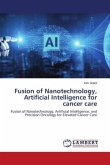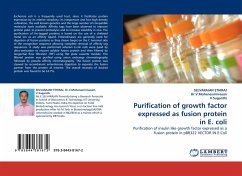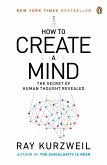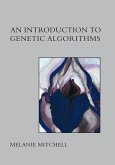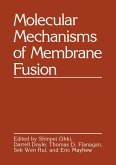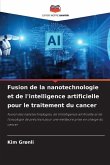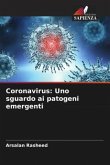Multimodal Data Fusion for Bioinformatics Artificial Intelligence
Herausgeber: Kumar, Abhishek; Dutt, Vishal; Lilhore, Umesh Kumar; Simaiya, Sarita; Vyas, Narayan
Multimodal Data Fusion for Bioinformatics Artificial Intelligence
Herausgeber: Kumar, Abhishek; Dutt, Vishal; Lilhore, Umesh Kumar; Simaiya, Sarita; Vyas, Narayan
- Gebundenes Buch
- Merkliste
- Auf die Merkliste
- Bewerten Bewerten
- Teilen
- Produkt teilen
- Produkterinnerung
- Produkterinnerung
Multimodal Data Fusion for Bioinformatics Artificial Intelligence is a must-have for anyone interested in the intersection of AI and bioinformatics, as it delves into innovative data fusion methods and their applications in 'omics' research while addressing the ethical implications and future developments shaping the field today. Multimodal Data Fusion for Bioinformatics Artificial Intelligence is an indispensable resource for those exploring how cutting-edge data fusion methods interact with the rapidly developing field of bioinformatics. Beginning with the basics of integrating different…mehr
Andere Kunden interessierten sich auch für
![Fusion of Nanotechnology, Artificial Intelligence for cancer care Fusion of Nanotechnology, Artificial Intelligence for cancer care]() Kim GrønliFusion of Nanotechnology, Artificial Intelligence for cancer care30,99 €
Kim GrønliFusion of Nanotechnology, Artificial Intelligence for cancer care30,99 €![Purification of growth factor expressed as fusion protein in E. coli Purification of growth factor expressed as fusion protein in E. coli]() Selvarajan EthirajPurification of growth factor expressed as fusion protein in E. coli33,99 €
Selvarajan EthirajPurification of growth factor expressed as fusion protein in E. coli33,99 €![How to Create a Mind How to Create a Mind]() Ray KurzweilHow to Create a Mind13,99 €
Ray KurzweilHow to Create a Mind13,99 €![An Introduction to Genetic Algorithms An Introduction to Genetic Algorithms]() Melanie MitchellAn Introduction to Genetic Algorithms45,99 €
Melanie MitchellAn Introduction to Genetic Algorithms45,99 €![Molecular Mechanisms of Membrane Fusion Molecular Mechanisms of Membrane Fusion]() Shinpei OhkiMolecular Mechanisms of Membrane Fusion117,99 €
Shinpei OhkiMolecular Mechanisms of Membrane Fusion117,99 €![Fusion de la nanotechnologie et de l'intelligence artificielle pour le traitement du cancer Fusion de la nanotechnologie et de l'intelligence artificielle pour le traitement du cancer]() Kim GrønliFusion de la nanotechnologie et de l'intelligence artificielle pour le traitement du cancer31,99 €
Kim GrønliFusion de la nanotechnologie et de l'intelligence artificielle pour le traitement du cancer31,99 €![Coronavirus: Uno sguardo ai patogeni emergenti Coronavirus: Uno sguardo ai patogeni emergenti]() Arsalan RasheedCoronavirus: Uno sguardo ai patogeni emergenti31,99 €
Arsalan RasheedCoronavirus: Uno sguardo ai patogeni emergenti31,99 €-
-
-
Multimodal Data Fusion for Bioinformatics Artificial Intelligence is a must-have for anyone interested in the intersection of AI and bioinformatics, as it delves into innovative data fusion methods and their applications in 'omics' research while addressing the ethical implications and future developments shaping the field today. Multimodal Data Fusion for Bioinformatics Artificial Intelligence is an indispensable resource for those exploring how cutting-edge data fusion methods interact with the rapidly developing field of bioinformatics. Beginning with the basics of integrating different data types, this book delves into the use of AI for processing and understanding complex "omics" data, ranging from genomics to metabolomics. The revolutionary potential of AI techniques in bioinformatics is thoroughly explored, including the use of neural networks, graph-based algorithms, single-cell RNA sequencing, and other cutting-edge topics. The second half of the book focuses on the ethical and practical implications of using AI in bioinformatics. The tangible benefits of these technologies in healthcare and research are highlighted in chapters devoted to precision medicine, drug development, and biomedical literature. The book addresses a wide range of ethical concerns, from data privacy to model interpretability, providing readers with a well-rounded education on the subject. Finally, the book explores forward-looking developments such as quantum computing and augmented reality in bioinformatics AI. This comprehensive resource offers a bird's-eye view of the intersection of AI, data fusion, and bioinformatics, catering to readers of all experience levels.
Hinweis: Dieser Artikel kann nur an eine deutsche Lieferadresse ausgeliefert werden.
Hinweis: Dieser Artikel kann nur an eine deutsche Lieferadresse ausgeliefert werden.
Produktdetails
- Produktdetails
- Verlag: John Wiley & Sons Inc
- Seitenzahl: 416
- Erscheinungstermin: 28. Januar 2025
- Englisch
- ISBN-13: 9781394269938
- ISBN-10: 1394269935
- Artikelnr.: 72737910
- Herstellerkennzeichnung
- Libri GmbH
- Europaallee 1
- 36244 Bad Hersfeld
- gpsr@libri.de
- Verlag: John Wiley & Sons Inc
- Seitenzahl: 416
- Erscheinungstermin: 28. Januar 2025
- Englisch
- ISBN-13: 9781394269938
- ISBN-10: 1394269935
- Artikelnr.: 72737910
- Herstellerkennzeichnung
- Libri GmbH
- Europaallee 1
- 36244 Bad Hersfeld
- gpsr@libri.de
Umesh Kumar Lilhore, PhD, is a postdoctoral research fellow at the University of Louisiana Lafayette, United States with more than 19 years of teaching experience and eight years of research experience. He has published many articles in reputed, peer-reviewed national and international Scopus journals and conferences. Additionally, he has served as a keynote speaker and resource person for several workshops and webinars conducted in India. Abhishek Kumar, PhD, is an assistant director and associate professor in the Computer Science and Engineering Department at Chandigarh University, Punjab, India with more than 11 years of teaching experience. He has over 100 publications in reputed, peer-reviewed national and international journals, books and conferences and has authored/coauthored six books and edited 25 books published internationally. He has been a session chair and keynote speaker at many international conferences and webinars in India and abroad and is a member of various national and international professional societies in the field of engineering and research. Narayan Vyas is a Technical Trainer for Research at Chandigarh University, India where he is actively involved in research and development in computer science and engineering. He has published many articles in reputed, peer-reviewed national and international Scopus journals and conferences. Additionally, he has served as a keynote speaker and resource person for several workshops and webinars conducted in India. He recently presented one article at the 2023 7th International Conference on Computing Methodologies and Communication and two articles at the 2023 International Conference on Artificial Intelligence and Smart Communication. Sarita Simaiya, PhD, is an associate professor at the Apex Institute of Technology, Department of Computer Science and Engineering, Chandigarh University, India. She has over 15 years of academic teaching experience and has published over 80 papers, presentations, and book chapters. Her research includes digital transformation technologies such as Cloud Computing, Health care, Artificial Intelligence (AI), Quantum Computing, Internet of Things (IoT), and Modal Learning. Vishal Dutt is an accomplished principal research consultant at AVN Innovations with extensive experience in academia and industry. He is a renowned freelance trainer for Android and Google Cloud with over seven years of academic teaching experience. He has authored over 50 publications in well-known and peer-reviewed national and international journals, SCI and Scopus journals, conferences, and book chapters. He has contributed to the editorial process of two books and is currently working on three more. Vishal has been a keynote speaker and a valuable resource for many workshops and webinars across India.
Preface xv
1 Advancements and Challenges in Multimodal Data Fusion for Bioinformatics
AI 1
Priya Batta
1.1 Introduction 1
1.2 Literature Review 4
1.3 Results and Discussion 8
2 Automated Machine Learning in Bioinformatics 13
Pushpendra Kumar, Gagan Thakral, Vivek Kumar and Upendra Mishra
2.1 Introduction 14
2.2 Need of Automated Machine Learning 16
2.3 Automated ML in Various Areas of Bioinformatics 19
2.4 Major Obstacles for Automated ML in Various Areas of Bioinformatics 23
2.5 Applications of Automated ML in Various Areas of Bioinformatics 24
2.6 Case Study 1 26
2.7 Conclusion and Future Directions 28
3 Data-Driven Discoveries: Unveiling Insights with Automated Methods 33
Rakhi Chauhan
3.1 Introduction 34
3.2 Important Functions in Bioinformatics Include Data Mining and Analysis
36
3.3 Deep Learning in Bioinformatics 39
3.4 Challenges and Issues 42
3.5 Conclusion 45
4 Comparative Analysis of Conventional Machine Learning and Deep Learning
Techniques for Predicting Parkinson's Disease 49
Monika Sethi and Vidhu Baggan
4.1 Introduction 50
4.2 Symptoms and Dataset for PD 52
4.3 Parkinson's Disease Classification Using Machine Learning Methods 53
4.4 Parkinson's Disease Classification Using DL Methods 57
4.5 Conclusion 59
5 Foundations of Multimodal Data Fusion 67
Srinivas Kumar Palvadi and G. Kadiravan
5.1 Introduction 68
5.2 What is Multimodal Data Fusion in Bioinformatics AI? 69
5.3 Types of Data Modalities in Bioinformatics 70
5.4 Challenges and Considerations in Multimodal Data Fusion 73
5.5 Foundational Principles of Data Fusion 77
5.6 Machine Learning and Deep Learning Techniques for Multimodal Data
Fusion 80
5.7 Feature Representation and Fusion 84
5.8 Applications in Bioinformatics AI 88
5.9 Evaluation Metrics and Validation Strategies 92
5.10 Evaluation Metrics 93
5.11 Approval Techniques 94
5.12 Ethical and Legal Considerations 95
5.13 Future Directions and Challenges 95
5.14 Conclusion 96
6 Integrating IoT, Blockchain, and Quantum Machine Learning: Advancing
Multimodal Data Fusion in Healthcare AI 103
Dankan Gowda V., J. Rajalakshmi, Guruprakash B., Venkatesan Hariram and K.
D. V. Prasad
6.1 Introduction 104
6.2 Internet of Things (IoT) in Healthcare 107
6.3 Blockchain Technology in Healthcare 111
6.4 Quantum Machine Learning in Healthcare 113
6.5 Integration of IoT, Blockchain, and Quantum Machine Learning in
Healthcare 116
6.6 Ethical and Regulatory Considerations in Healthcare Technology 118
6.7 Challenges and Future Directions in Healthcare Technology Integration
119
6.8 Results and Discussion 121
6.9 Conclusion 122
7 Integrating Multimodal Data Fusion for Advanced Biomedical Analysis: A
Comprehensive Review 127
Umesh Kumar Lilhore and Sarita Simaiya
7.1 Introduction 128
7.2 Multimodal Biomedical Analysis 130
7.3 Challenges in Data Fusion 132
7.4 Deep Learning Methods for Data Fusion 134
7.5 Case Studies and Applications 136
7.6 Future Directions 139
7.7 Conclusion 142
8 Machine Learning Approaches for Integrating Imaging and Molecular Data in
Bioinformatics 147
Mandeep Kaur, Dankan Gowda V., Priya. S., K.D.V. Prasad and Venkatesan
Hariram
8.1 Introduction 148
8.2 Background and Motivation 152
8.3 Machine Learning Basics 154
8.4 Approaches for Data Integration 156
8.5 Machine Learning Techniques for Imaging and Molecular Data 167
8.6 Applications 168
8.7 Challenges and Future Directions 170
8.8 Case Studies 172
8.9 Conclusion 174
9 Time Series Analysis in Functional Genomics 179
Yash Mahajan, Inderjeet Singh, Muskan Sharma and Shweta Sharma
9.1 Introduction 180
9.2 Foundations of Time Series Analysis in Functional Genomics 182
9.3 Methodologies for Time Series Analysis 186
9.4 Applications of Time Series Analysis in Functional Genomics 194
9.5 Integration with Multimodal Data 196
9.6 Conclusion 199
10 Review of Multimodal Data Fusion in Machine Learning: Methods,
Challenges, Opportunities 205
Leena Arya, Yogesh Kumar Sharma, Smitha and Sreelakshmi Doma
10.1 Introduction 206
10.2 Related Work 208
10.3 Multimodal and Data Fusion 211
10.4 Applications, Opportunities, and Challenges 216
10.5 Conclusion and Future Directions 219
11 Recent Advancement in Bioinformatics: An In-Depth Analysis of AI
Techniques 227
Yogesh Kumar Sharma, Leena Arya, Smitha and Shaik Saddam Hussain
11.1 Introduction 228
11.2 AutoMLDL Methods 230
11.3 Application of AutoMLDL in Bioinformatics 233
11.4 Advanced Algorithm in AutoMLDL for Bioinformatics 238
11.5 Security and Privacy Issues in AutoMLDL 240
11.6 Conclusion and Future Works 241
12 Future Directions and Emerging Trends in Multimodal Data Fusion for
Bioinformatics 247
Dankan Gowda V., D. Palanikkumar, K.D.V. Prasad, Mandeep Kaur and Shivoham
Singh
12.1 Introduction 248
12.2 Foundational Concepts 253
12.3 Current State of Multimodal Data Fusion in Bioinformatics 258
12.4 Emerging Trends in Data Fusion 260
12.5 Algorithms 266
12.6 Future Directions 272
12.7 Case Studies and Applications 274
12.8 Challenges and Opportunities 276
12.9 Conclusion 278
13 Future Trends in Bioinformatics AI Integration 283
Srinivas Kumar Palvadi and G. Kadiravan
13.1 Introduction 284
13.2 What Is Multimodal Data Fusion? 285
13.3 Types of Multimodal Data in Bioinformatics 286
13.4 Challenges in Multimodal Data Fusion 288
13.5 Multimodal Data Integration Approaches 288
13.6 Feature Representation and Selection 289
13.7 Integration of Omics Data 290
13.8 Clinical Applications 291
13.9 Imaging Data Fusion 292
13.10 Biological Network Integration 294
13.11 Applications in Precision Medicine 295
13.12 Computational Tools and Resources 297
13.13 Future Directions and Challenges 298
13.14 Conclusion 300
14 Emerging Technologies in IoM: AI, Blockchain and Beyond 305
Sumit Bansal and Vandana Sindhi
14.1 Introduction 306
14.2 Artificial Intelligence (AI) in Healthcare 307
14.3 Blockchain in the Medical Landscape 309
14.4 Benefits of Using Technologies in IoM 311
14.5 Integration of Cutting-Edge Technologies 314
14.6 Beyond AI and Blockchain: Exploring Additional Technologies 315
14.7 Ethical Considerations in Implementing Emerging Technologies 317
14.8 Conclusion 319
15 Natural Language Processing in Biomedical Literature 323
Molina Mukherjee, Prachi Punia, Adil Husain Rather and Hardik Dhiman
15.1 Introduction 324
15.2 History 326
15.3 Theoretical Foundation: Natural Language Processing in Scientific
Writing 327
15.4 Sources of Diversity in Biomedical Literature's Natural Language
Processing 330
15.5 Disagreement and Conflict 332
15.6 Natural Language Processing Trends and Patterns in Biomedical
Literature 332
15.7 Natural Language Processing's Useful Applications in Biomedical
Literature 334
15.8 Future Prospects of NLP in Biomedical Literature 336
15.9 Conclusion 337
16 Biomedical Research Enrichment Through Sentiment Analysis in Patient
Feedback: A Natural Language Processing Approach 341
Soumitra Saha, Umesh Kumar Lilhore and Sarita Simaiya
16.1 Introduction 342
16.2 Applications of NLP 346
16.3 Background Studies in Sentimental Analysis 353
16.4 Processes Needed for Sentimental Analysis 359
16.5 Conclusion 369
Acknowledgment 370
References 370
About the Editors 375
Index 377
1 Advancements and Challenges in Multimodal Data Fusion for Bioinformatics
AI 1
Priya Batta
1.1 Introduction 1
1.2 Literature Review 4
1.3 Results and Discussion 8
2 Automated Machine Learning in Bioinformatics 13
Pushpendra Kumar, Gagan Thakral, Vivek Kumar and Upendra Mishra
2.1 Introduction 14
2.2 Need of Automated Machine Learning 16
2.3 Automated ML in Various Areas of Bioinformatics 19
2.4 Major Obstacles for Automated ML in Various Areas of Bioinformatics 23
2.5 Applications of Automated ML in Various Areas of Bioinformatics 24
2.6 Case Study 1 26
2.7 Conclusion and Future Directions 28
3 Data-Driven Discoveries: Unveiling Insights with Automated Methods 33
Rakhi Chauhan
3.1 Introduction 34
3.2 Important Functions in Bioinformatics Include Data Mining and Analysis
36
3.3 Deep Learning in Bioinformatics 39
3.4 Challenges and Issues 42
3.5 Conclusion 45
4 Comparative Analysis of Conventional Machine Learning and Deep Learning
Techniques for Predicting Parkinson's Disease 49
Monika Sethi and Vidhu Baggan
4.1 Introduction 50
4.2 Symptoms and Dataset for PD 52
4.3 Parkinson's Disease Classification Using Machine Learning Methods 53
4.4 Parkinson's Disease Classification Using DL Methods 57
4.5 Conclusion 59
5 Foundations of Multimodal Data Fusion 67
Srinivas Kumar Palvadi and G. Kadiravan
5.1 Introduction 68
5.2 What is Multimodal Data Fusion in Bioinformatics AI? 69
5.3 Types of Data Modalities in Bioinformatics 70
5.4 Challenges and Considerations in Multimodal Data Fusion 73
5.5 Foundational Principles of Data Fusion 77
5.6 Machine Learning and Deep Learning Techniques for Multimodal Data
Fusion 80
5.7 Feature Representation and Fusion 84
5.8 Applications in Bioinformatics AI 88
5.9 Evaluation Metrics and Validation Strategies 92
5.10 Evaluation Metrics 93
5.11 Approval Techniques 94
5.12 Ethical and Legal Considerations 95
5.13 Future Directions and Challenges 95
5.14 Conclusion 96
6 Integrating IoT, Blockchain, and Quantum Machine Learning: Advancing
Multimodal Data Fusion in Healthcare AI 103
Dankan Gowda V., J. Rajalakshmi, Guruprakash B., Venkatesan Hariram and K.
D. V. Prasad
6.1 Introduction 104
6.2 Internet of Things (IoT) in Healthcare 107
6.3 Blockchain Technology in Healthcare 111
6.4 Quantum Machine Learning in Healthcare 113
6.5 Integration of IoT, Blockchain, and Quantum Machine Learning in
Healthcare 116
6.6 Ethical and Regulatory Considerations in Healthcare Technology 118
6.7 Challenges and Future Directions in Healthcare Technology Integration
119
6.8 Results and Discussion 121
6.9 Conclusion 122
7 Integrating Multimodal Data Fusion for Advanced Biomedical Analysis: A
Comprehensive Review 127
Umesh Kumar Lilhore and Sarita Simaiya
7.1 Introduction 128
7.2 Multimodal Biomedical Analysis 130
7.3 Challenges in Data Fusion 132
7.4 Deep Learning Methods for Data Fusion 134
7.5 Case Studies and Applications 136
7.6 Future Directions 139
7.7 Conclusion 142
8 Machine Learning Approaches for Integrating Imaging and Molecular Data in
Bioinformatics 147
Mandeep Kaur, Dankan Gowda V., Priya. S., K.D.V. Prasad and Venkatesan
Hariram
8.1 Introduction 148
8.2 Background and Motivation 152
8.3 Machine Learning Basics 154
8.4 Approaches for Data Integration 156
8.5 Machine Learning Techniques for Imaging and Molecular Data 167
8.6 Applications 168
8.7 Challenges and Future Directions 170
8.8 Case Studies 172
8.9 Conclusion 174
9 Time Series Analysis in Functional Genomics 179
Yash Mahajan, Inderjeet Singh, Muskan Sharma and Shweta Sharma
9.1 Introduction 180
9.2 Foundations of Time Series Analysis in Functional Genomics 182
9.3 Methodologies for Time Series Analysis 186
9.4 Applications of Time Series Analysis in Functional Genomics 194
9.5 Integration with Multimodal Data 196
9.6 Conclusion 199
10 Review of Multimodal Data Fusion in Machine Learning: Methods,
Challenges, Opportunities 205
Leena Arya, Yogesh Kumar Sharma, Smitha and Sreelakshmi Doma
10.1 Introduction 206
10.2 Related Work 208
10.3 Multimodal and Data Fusion 211
10.4 Applications, Opportunities, and Challenges 216
10.5 Conclusion and Future Directions 219
11 Recent Advancement in Bioinformatics: An In-Depth Analysis of AI
Techniques 227
Yogesh Kumar Sharma, Leena Arya, Smitha and Shaik Saddam Hussain
11.1 Introduction 228
11.2 AutoMLDL Methods 230
11.3 Application of AutoMLDL in Bioinformatics 233
11.4 Advanced Algorithm in AutoMLDL for Bioinformatics 238
11.5 Security and Privacy Issues in AutoMLDL 240
11.6 Conclusion and Future Works 241
12 Future Directions and Emerging Trends in Multimodal Data Fusion for
Bioinformatics 247
Dankan Gowda V., D. Palanikkumar, K.D.V. Prasad, Mandeep Kaur and Shivoham
Singh
12.1 Introduction 248
12.2 Foundational Concepts 253
12.3 Current State of Multimodal Data Fusion in Bioinformatics 258
12.4 Emerging Trends in Data Fusion 260
12.5 Algorithms 266
12.6 Future Directions 272
12.7 Case Studies and Applications 274
12.8 Challenges and Opportunities 276
12.9 Conclusion 278
13 Future Trends in Bioinformatics AI Integration 283
Srinivas Kumar Palvadi and G. Kadiravan
13.1 Introduction 284
13.2 What Is Multimodal Data Fusion? 285
13.3 Types of Multimodal Data in Bioinformatics 286
13.4 Challenges in Multimodal Data Fusion 288
13.5 Multimodal Data Integration Approaches 288
13.6 Feature Representation and Selection 289
13.7 Integration of Omics Data 290
13.8 Clinical Applications 291
13.9 Imaging Data Fusion 292
13.10 Biological Network Integration 294
13.11 Applications in Precision Medicine 295
13.12 Computational Tools and Resources 297
13.13 Future Directions and Challenges 298
13.14 Conclusion 300
14 Emerging Technologies in IoM: AI, Blockchain and Beyond 305
Sumit Bansal and Vandana Sindhi
14.1 Introduction 306
14.2 Artificial Intelligence (AI) in Healthcare 307
14.3 Blockchain in the Medical Landscape 309
14.4 Benefits of Using Technologies in IoM 311
14.5 Integration of Cutting-Edge Technologies 314
14.6 Beyond AI and Blockchain: Exploring Additional Technologies 315
14.7 Ethical Considerations in Implementing Emerging Technologies 317
14.8 Conclusion 319
15 Natural Language Processing in Biomedical Literature 323
Molina Mukherjee, Prachi Punia, Adil Husain Rather and Hardik Dhiman
15.1 Introduction 324
15.2 History 326
15.3 Theoretical Foundation: Natural Language Processing in Scientific
Writing 327
15.4 Sources of Diversity in Biomedical Literature's Natural Language
Processing 330
15.5 Disagreement and Conflict 332
15.6 Natural Language Processing Trends and Patterns in Biomedical
Literature 332
15.7 Natural Language Processing's Useful Applications in Biomedical
Literature 334
15.8 Future Prospects of NLP in Biomedical Literature 336
15.9 Conclusion 337
16 Biomedical Research Enrichment Through Sentiment Analysis in Patient
Feedback: A Natural Language Processing Approach 341
Soumitra Saha, Umesh Kumar Lilhore and Sarita Simaiya
16.1 Introduction 342
16.2 Applications of NLP 346
16.3 Background Studies in Sentimental Analysis 353
16.4 Processes Needed for Sentimental Analysis 359
16.5 Conclusion 369
Acknowledgment 370
References 370
About the Editors 375
Index 377
Preface xv
1 Advancements and Challenges in Multimodal Data Fusion for Bioinformatics
AI 1
Priya Batta
1.1 Introduction 1
1.2 Literature Review 4
1.3 Results and Discussion 8
2 Automated Machine Learning in Bioinformatics 13
Pushpendra Kumar, Gagan Thakral, Vivek Kumar and Upendra Mishra
2.1 Introduction 14
2.2 Need of Automated Machine Learning 16
2.3 Automated ML in Various Areas of Bioinformatics 19
2.4 Major Obstacles for Automated ML in Various Areas of Bioinformatics 23
2.5 Applications of Automated ML in Various Areas of Bioinformatics 24
2.6 Case Study 1 26
2.7 Conclusion and Future Directions 28
3 Data-Driven Discoveries: Unveiling Insights with Automated Methods 33
Rakhi Chauhan
3.1 Introduction 34
3.2 Important Functions in Bioinformatics Include Data Mining and Analysis
36
3.3 Deep Learning in Bioinformatics 39
3.4 Challenges and Issues 42
3.5 Conclusion 45
4 Comparative Analysis of Conventional Machine Learning and Deep Learning
Techniques for Predicting Parkinson's Disease 49
Monika Sethi and Vidhu Baggan
4.1 Introduction 50
4.2 Symptoms and Dataset for PD 52
4.3 Parkinson's Disease Classification Using Machine Learning Methods 53
4.4 Parkinson's Disease Classification Using DL Methods 57
4.5 Conclusion 59
5 Foundations of Multimodal Data Fusion 67
Srinivas Kumar Palvadi and G. Kadiravan
5.1 Introduction 68
5.2 What is Multimodal Data Fusion in Bioinformatics AI? 69
5.3 Types of Data Modalities in Bioinformatics 70
5.4 Challenges and Considerations in Multimodal Data Fusion 73
5.5 Foundational Principles of Data Fusion 77
5.6 Machine Learning and Deep Learning Techniques for Multimodal Data
Fusion 80
5.7 Feature Representation and Fusion 84
5.8 Applications in Bioinformatics AI 88
5.9 Evaluation Metrics and Validation Strategies 92
5.10 Evaluation Metrics 93
5.11 Approval Techniques 94
5.12 Ethical and Legal Considerations 95
5.13 Future Directions and Challenges 95
5.14 Conclusion 96
6 Integrating IoT, Blockchain, and Quantum Machine Learning: Advancing
Multimodal Data Fusion in Healthcare AI 103
Dankan Gowda V., J. Rajalakshmi, Guruprakash B., Venkatesan Hariram and K.
D. V. Prasad
6.1 Introduction 104
6.2 Internet of Things (IoT) in Healthcare 107
6.3 Blockchain Technology in Healthcare 111
6.4 Quantum Machine Learning in Healthcare 113
6.5 Integration of IoT, Blockchain, and Quantum Machine Learning in
Healthcare 116
6.6 Ethical and Regulatory Considerations in Healthcare Technology 118
6.7 Challenges and Future Directions in Healthcare Technology Integration
119
6.8 Results and Discussion 121
6.9 Conclusion 122
7 Integrating Multimodal Data Fusion for Advanced Biomedical Analysis: A
Comprehensive Review 127
Umesh Kumar Lilhore and Sarita Simaiya
7.1 Introduction 128
7.2 Multimodal Biomedical Analysis 130
7.3 Challenges in Data Fusion 132
7.4 Deep Learning Methods for Data Fusion 134
7.5 Case Studies and Applications 136
7.6 Future Directions 139
7.7 Conclusion 142
8 Machine Learning Approaches for Integrating Imaging and Molecular Data in
Bioinformatics 147
Mandeep Kaur, Dankan Gowda V., Priya. S., K.D.V. Prasad and Venkatesan
Hariram
8.1 Introduction 148
8.2 Background and Motivation 152
8.3 Machine Learning Basics 154
8.4 Approaches for Data Integration 156
8.5 Machine Learning Techniques for Imaging and Molecular Data 167
8.6 Applications 168
8.7 Challenges and Future Directions 170
8.8 Case Studies 172
8.9 Conclusion 174
9 Time Series Analysis in Functional Genomics 179
Yash Mahajan, Inderjeet Singh, Muskan Sharma and Shweta Sharma
9.1 Introduction 180
9.2 Foundations of Time Series Analysis in Functional Genomics 182
9.3 Methodologies for Time Series Analysis 186
9.4 Applications of Time Series Analysis in Functional Genomics 194
9.5 Integration with Multimodal Data 196
9.6 Conclusion 199
10 Review of Multimodal Data Fusion in Machine Learning: Methods,
Challenges, Opportunities 205
Leena Arya, Yogesh Kumar Sharma, Smitha and Sreelakshmi Doma
10.1 Introduction 206
10.2 Related Work 208
10.3 Multimodal and Data Fusion 211
10.4 Applications, Opportunities, and Challenges 216
10.5 Conclusion and Future Directions 219
11 Recent Advancement in Bioinformatics: An In-Depth Analysis of AI
Techniques 227
Yogesh Kumar Sharma, Leena Arya, Smitha and Shaik Saddam Hussain
11.1 Introduction 228
11.2 AutoMLDL Methods 230
11.3 Application of AutoMLDL in Bioinformatics 233
11.4 Advanced Algorithm in AutoMLDL for Bioinformatics 238
11.5 Security and Privacy Issues in AutoMLDL 240
11.6 Conclusion and Future Works 241
12 Future Directions and Emerging Trends in Multimodal Data Fusion for
Bioinformatics 247
Dankan Gowda V., D. Palanikkumar, K.D.V. Prasad, Mandeep Kaur and Shivoham
Singh
12.1 Introduction 248
12.2 Foundational Concepts 253
12.3 Current State of Multimodal Data Fusion in Bioinformatics 258
12.4 Emerging Trends in Data Fusion 260
12.5 Algorithms 266
12.6 Future Directions 272
12.7 Case Studies and Applications 274
12.8 Challenges and Opportunities 276
12.9 Conclusion 278
13 Future Trends in Bioinformatics AI Integration 283
Srinivas Kumar Palvadi and G. Kadiravan
13.1 Introduction 284
13.2 What Is Multimodal Data Fusion? 285
13.3 Types of Multimodal Data in Bioinformatics 286
13.4 Challenges in Multimodal Data Fusion 288
13.5 Multimodal Data Integration Approaches 288
13.6 Feature Representation and Selection 289
13.7 Integration of Omics Data 290
13.8 Clinical Applications 291
13.9 Imaging Data Fusion 292
13.10 Biological Network Integration 294
13.11 Applications in Precision Medicine 295
13.12 Computational Tools and Resources 297
13.13 Future Directions and Challenges 298
13.14 Conclusion 300
14 Emerging Technologies in IoM: AI, Blockchain and Beyond 305
Sumit Bansal and Vandana Sindhi
14.1 Introduction 306
14.2 Artificial Intelligence (AI) in Healthcare 307
14.3 Blockchain in the Medical Landscape 309
14.4 Benefits of Using Technologies in IoM 311
14.5 Integration of Cutting-Edge Technologies 314
14.6 Beyond AI and Blockchain: Exploring Additional Technologies 315
14.7 Ethical Considerations in Implementing Emerging Technologies 317
14.8 Conclusion 319
15 Natural Language Processing in Biomedical Literature 323
Molina Mukherjee, Prachi Punia, Adil Husain Rather and Hardik Dhiman
15.1 Introduction 324
15.2 History 326
15.3 Theoretical Foundation: Natural Language Processing in Scientific
Writing 327
15.4 Sources of Diversity in Biomedical Literature's Natural Language
Processing 330
15.5 Disagreement and Conflict 332
15.6 Natural Language Processing Trends and Patterns in Biomedical
Literature 332
15.7 Natural Language Processing's Useful Applications in Biomedical
Literature 334
15.8 Future Prospects of NLP in Biomedical Literature 336
15.9 Conclusion 337
16 Biomedical Research Enrichment Through Sentiment Analysis in Patient
Feedback: A Natural Language Processing Approach 341
Soumitra Saha, Umesh Kumar Lilhore and Sarita Simaiya
16.1 Introduction 342
16.2 Applications of NLP 346
16.3 Background Studies in Sentimental Analysis 353
16.4 Processes Needed for Sentimental Analysis 359
16.5 Conclusion 369
Acknowledgment 370
References 370
About the Editors 375
Index 377
1 Advancements and Challenges in Multimodal Data Fusion for Bioinformatics
AI 1
Priya Batta
1.1 Introduction 1
1.2 Literature Review 4
1.3 Results and Discussion 8
2 Automated Machine Learning in Bioinformatics 13
Pushpendra Kumar, Gagan Thakral, Vivek Kumar and Upendra Mishra
2.1 Introduction 14
2.2 Need of Automated Machine Learning 16
2.3 Automated ML in Various Areas of Bioinformatics 19
2.4 Major Obstacles for Automated ML in Various Areas of Bioinformatics 23
2.5 Applications of Automated ML in Various Areas of Bioinformatics 24
2.6 Case Study 1 26
2.7 Conclusion and Future Directions 28
3 Data-Driven Discoveries: Unveiling Insights with Automated Methods 33
Rakhi Chauhan
3.1 Introduction 34
3.2 Important Functions in Bioinformatics Include Data Mining and Analysis
36
3.3 Deep Learning in Bioinformatics 39
3.4 Challenges and Issues 42
3.5 Conclusion 45
4 Comparative Analysis of Conventional Machine Learning and Deep Learning
Techniques for Predicting Parkinson's Disease 49
Monika Sethi and Vidhu Baggan
4.1 Introduction 50
4.2 Symptoms and Dataset for PD 52
4.3 Parkinson's Disease Classification Using Machine Learning Methods 53
4.4 Parkinson's Disease Classification Using DL Methods 57
4.5 Conclusion 59
5 Foundations of Multimodal Data Fusion 67
Srinivas Kumar Palvadi and G. Kadiravan
5.1 Introduction 68
5.2 What is Multimodal Data Fusion in Bioinformatics AI? 69
5.3 Types of Data Modalities in Bioinformatics 70
5.4 Challenges and Considerations in Multimodal Data Fusion 73
5.5 Foundational Principles of Data Fusion 77
5.6 Machine Learning and Deep Learning Techniques for Multimodal Data
Fusion 80
5.7 Feature Representation and Fusion 84
5.8 Applications in Bioinformatics AI 88
5.9 Evaluation Metrics and Validation Strategies 92
5.10 Evaluation Metrics 93
5.11 Approval Techniques 94
5.12 Ethical and Legal Considerations 95
5.13 Future Directions and Challenges 95
5.14 Conclusion 96
6 Integrating IoT, Blockchain, and Quantum Machine Learning: Advancing
Multimodal Data Fusion in Healthcare AI 103
Dankan Gowda V., J. Rajalakshmi, Guruprakash B., Venkatesan Hariram and K.
D. V. Prasad
6.1 Introduction 104
6.2 Internet of Things (IoT) in Healthcare 107
6.3 Blockchain Technology in Healthcare 111
6.4 Quantum Machine Learning in Healthcare 113
6.5 Integration of IoT, Blockchain, and Quantum Machine Learning in
Healthcare 116
6.6 Ethical and Regulatory Considerations in Healthcare Technology 118
6.7 Challenges and Future Directions in Healthcare Technology Integration
119
6.8 Results and Discussion 121
6.9 Conclusion 122
7 Integrating Multimodal Data Fusion for Advanced Biomedical Analysis: A
Comprehensive Review 127
Umesh Kumar Lilhore and Sarita Simaiya
7.1 Introduction 128
7.2 Multimodal Biomedical Analysis 130
7.3 Challenges in Data Fusion 132
7.4 Deep Learning Methods for Data Fusion 134
7.5 Case Studies and Applications 136
7.6 Future Directions 139
7.7 Conclusion 142
8 Machine Learning Approaches for Integrating Imaging and Molecular Data in
Bioinformatics 147
Mandeep Kaur, Dankan Gowda V., Priya. S., K.D.V. Prasad and Venkatesan
Hariram
8.1 Introduction 148
8.2 Background and Motivation 152
8.3 Machine Learning Basics 154
8.4 Approaches for Data Integration 156
8.5 Machine Learning Techniques for Imaging and Molecular Data 167
8.6 Applications 168
8.7 Challenges and Future Directions 170
8.8 Case Studies 172
8.9 Conclusion 174
9 Time Series Analysis in Functional Genomics 179
Yash Mahajan, Inderjeet Singh, Muskan Sharma and Shweta Sharma
9.1 Introduction 180
9.2 Foundations of Time Series Analysis in Functional Genomics 182
9.3 Methodologies for Time Series Analysis 186
9.4 Applications of Time Series Analysis in Functional Genomics 194
9.5 Integration with Multimodal Data 196
9.6 Conclusion 199
10 Review of Multimodal Data Fusion in Machine Learning: Methods,
Challenges, Opportunities 205
Leena Arya, Yogesh Kumar Sharma, Smitha and Sreelakshmi Doma
10.1 Introduction 206
10.2 Related Work 208
10.3 Multimodal and Data Fusion 211
10.4 Applications, Opportunities, and Challenges 216
10.5 Conclusion and Future Directions 219
11 Recent Advancement in Bioinformatics: An In-Depth Analysis of AI
Techniques 227
Yogesh Kumar Sharma, Leena Arya, Smitha and Shaik Saddam Hussain
11.1 Introduction 228
11.2 AutoMLDL Methods 230
11.3 Application of AutoMLDL in Bioinformatics 233
11.4 Advanced Algorithm in AutoMLDL for Bioinformatics 238
11.5 Security and Privacy Issues in AutoMLDL 240
11.6 Conclusion and Future Works 241
12 Future Directions and Emerging Trends in Multimodal Data Fusion for
Bioinformatics 247
Dankan Gowda V., D. Palanikkumar, K.D.V. Prasad, Mandeep Kaur and Shivoham
Singh
12.1 Introduction 248
12.2 Foundational Concepts 253
12.3 Current State of Multimodal Data Fusion in Bioinformatics 258
12.4 Emerging Trends in Data Fusion 260
12.5 Algorithms 266
12.6 Future Directions 272
12.7 Case Studies and Applications 274
12.8 Challenges and Opportunities 276
12.9 Conclusion 278
13 Future Trends in Bioinformatics AI Integration 283
Srinivas Kumar Palvadi and G. Kadiravan
13.1 Introduction 284
13.2 What Is Multimodal Data Fusion? 285
13.3 Types of Multimodal Data in Bioinformatics 286
13.4 Challenges in Multimodal Data Fusion 288
13.5 Multimodal Data Integration Approaches 288
13.6 Feature Representation and Selection 289
13.7 Integration of Omics Data 290
13.8 Clinical Applications 291
13.9 Imaging Data Fusion 292
13.10 Biological Network Integration 294
13.11 Applications in Precision Medicine 295
13.12 Computational Tools and Resources 297
13.13 Future Directions and Challenges 298
13.14 Conclusion 300
14 Emerging Technologies in IoM: AI, Blockchain and Beyond 305
Sumit Bansal and Vandana Sindhi
14.1 Introduction 306
14.2 Artificial Intelligence (AI) in Healthcare 307
14.3 Blockchain in the Medical Landscape 309
14.4 Benefits of Using Technologies in IoM 311
14.5 Integration of Cutting-Edge Technologies 314
14.6 Beyond AI and Blockchain: Exploring Additional Technologies 315
14.7 Ethical Considerations in Implementing Emerging Technologies 317
14.8 Conclusion 319
15 Natural Language Processing in Biomedical Literature 323
Molina Mukherjee, Prachi Punia, Adil Husain Rather and Hardik Dhiman
15.1 Introduction 324
15.2 History 326
15.3 Theoretical Foundation: Natural Language Processing in Scientific
Writing 327
15.4 Sources of Diversity in Biomedical Literature's Natural Language
Processing 330
15.5 Disagreement and Conflict 332
15.6 Natural Language Processing Trends and Patterns in Biomedical
Literature 332
15.7 Natural Language Processing's Useful Applications in Biomedical
Literature 334
15.8 Future Prospects of NLP in Biomedical Literature 336
15.9 Conclusion 337
16 Biomedical Research Enrichment Through Sentiment Analysis in Patient
Feedback: A Natural Language Processing Approach 341
Soumitra Saha, Umesh Kumar Lilhore and Sarita Simaiya
16.1 Introduction 342
16.2 Applications of NLP 346
16.3 Background Studies in Sentimental Analysis 353
16.4 Processes Needed for Sentimental Analysis 359
16.5 Conclusion 369
Acknowledgment 370
References 370
About the Editors 375
Index 377


